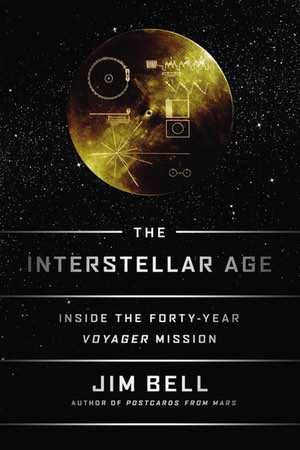Review: The Interstellar Ageby Jeff Foust
|
| “The trajectory of my life has been guided by the slow, gentle, persistent gravitational pull of two elegant robotic spacecraft and the teams of people… who made their missions of exploration so marvelously compelling.” |
But for us Gen X’ers who grew up in the late 1970s and the 1980s, the pickings were slim. The wave of missions at the beginning of the Space Age had long since crested, and the surge of missions in the 1990s and beyond had yet to begin. What we lacked in quantity of missions, though, we made up for in quality. NASA’s twin Voyager missions took us on an unparalleled expedition to the outer solar system, giving us our first look at a menagerie of planets and moons that dazzled the imaginations of scientists and the general public alike.
That included Jim Bell, a planetary scientist and president of The Planetary Society. “The trajectory of my life has been guided by the slow, gentle, persistent gravitational pull of two elegant robotic spacecraft and the teams of people… who made their missions of exploration so marvelously compelling,” he writes in the prelude of his new book The Interstellar Age, which offers a uniquely personal look—part memoir, part project history—at the Voyager missions.
Bell was not involved in the development, launch, or operations of Voyager as the two spacecraft flew past Jupiter in 1979 and Saturn in 1980 and 1981. He was a student in Rhode Island, following them from a distance, learning as much about them as he could given then limited information available in that pre-Web era. As an undergrad at Caltech in the mid-1980s, he got a job working for a member of the Voyager imaging team, developing software that helped the mission plan Voyager 2’s encounter with Uranus.
That work earned him a badge that got him into the science operations room during the flyby, where his primary role was as spectator and occasional gofer, delivering photocopies or food. “In fact, my primary contribution to the Voyager flyby of Uranus may have been to help keep some of the key team members from dying of starvation,” he writes. “I didn’t care—I was in the room.” He got back in the room for the Neptune flyby in 1989, now as a graduate student at the University of Hawaii, but again in that gofer role, assisting the science team while taking the opportunity to “soak it all up” in that final planetary flyby.
While Bell primarily had a cameo role in Voyager, he offers a fuller view of the mission through interviews with many of the key people involved with it, from Ed Stone, who has been Voyager project science since its beginning, to the scientists and technical staff who labored long hours preparing for the flybys, then spending their days and nights at JPL during the flybys. After all, like Bell, they wanted to be “in the room” as Voyager offered them the first views of these distant worlds.
The Interstellar Age is not a book solely about the discoveries made by scientists pouring through the images and other data Voyager returned, although Bell does devote one chapter to each planet the spacecraft flew past, describing the flybys and the results. It’s also not a formal project history: while Bell talks about the development of the mission—including a chapter on the “golden records” they carried as messages from humanity into the cosmos—it’s a personal account, not an academic one. Bell and the Voyager team members he interviews provide both the big picture and individual anecdotes that turn the story of these robotic missions into a very human account. That makes perfect sense: after all, the Voyager spacecraft, while sometime anthropomorphized like other spacecraft, were tools of the engineers who designed them and the scientists who used them to extend our reach deep into the outer solar system.
| Whenever Voyager sends its final downlink, it will be a final chapter for one of the most remarkable missions in the history of planetary exploration. Or, perhaps, that won’t be Voyager’s final chapter. |
The book is also a reminder that the Voyager missions are not over. While it’s been more than 25 years since Voyager 2’s Neptune flyby (its classic solar system image, revealing the Earth as a “pale blue dot,” was taken 25 years ago this month), both spacecraft continue to operate today, probing the boundaries of interstellar space. Stone is still actively involved, with a Caltech grad student—born a year before Voyager 2’s Neptune flyby—working with him to see if, and when, the Voyagers exit the heliosphere. “Somebody’s going to have to run it in the future,” said that grad student, Jamie Sue Rankin, as the members of the Voyager team retire. “Voyager is like the Energizer Bunny—it keeps on running!”
But like Energizer batteries, the Voyagers will eventfully stop running, as their nuclear batteries slowly decay and their growing distances make communications increasingly difficult. The Voyager team hopes the spacecraft can last another decade, and possibly longer, gradually shutting down instruments to conserve power. Suzy Dodd, whose first job at JPL in the 1980s was sequencing commands for Voyager and returned to the mission in 2010 as project manager, hopes to keep the spacecraft running to 2027. “That’s my goal—to have Voyager operate for fifty years,” she tells Bell.
Whenever Voyager sends its final downlink, it will be a final chapter for one of the most remarkable missions in the history of planetary exploration. Or, perhaps, that won’t be Voyager’s final chapter. Each spacecraft carries the golden record, on the unlikely chance an alien civilization comes across one of the spacecraft. More importantly, perhaps, is that Voyager helped shape the field of planetary science and the people like Bell who worked on, or were inspired by, the mission. Those people will be writing new chapters on planetary exploration for decades to come.
